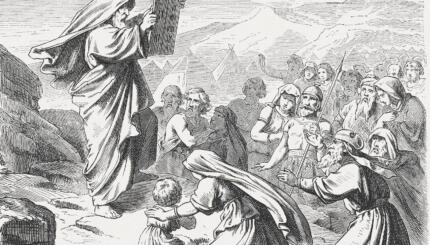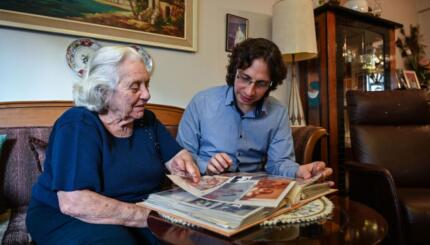Commentary on Parashat Nitzavim, Deuteronomy 29:9 - 30:20
I can remember exactly where I was sitting in the college library when I first understood philosophically why every person in the human race was deserving of equal concern — my concern. The book I was reading, for a course called “Justice,” was Immanuel Kant’s Grounding for the Metaphysics of Morals — not exactly a poetic read. Maybe that’s why I had walked clear across campus to the farthest library to seek out a quiet corner by a window where I could read the dense sentences without distraction.
Kant’s essay turned out to be the most straightforward statement and “proof” I had ever seen of the moral equality of everyone as “an end in himself.” For the first time I felt a strong intellectual foundation for the beliefs and values I had absorbed growing up.
It wasn’t too long before I was deflated by the discussion section leader, who noted that on a sinking boat, even people who loved Kant would probably save a family member first. So first-term freshman year, the issue was framed for me: the philosophical commitment to all people anywhere versus the emotional commitment to familiar people — family and community. It is a tension at the root of democratic theory and a psychological test for everyone involved in social action.
The Solution
Through the Modern Age, those who have read Deuteronomy through the lens of political action have often cited the beginning of Parashat Nitzavim as a solution to this tension. Speaking in front of the entire nation of Israel, Moses declares (in verses 29:9-11 and 13-14):
You are standing, all of you, before Adonai your God–your leaders, your tribes, your elders, your officials, every person in Israel; your wives, your children, and the stranger in the midst of your camp, from the one who chops your wood to the one who draws your water–so that you may pass into the covenant of Adonai your God…and not with you alone do I make this covenant and this oath, but with he who is present, standing here with us today before Adonai our God, and with him who is not here with us today.
Though Moses names every class and subgroup within the community, he simultaneously invites his audience to let go of the labels and the social segregation they represent. Moses encounters people with little personal experience of being together as more than a community of convenience. These people didn’t experience and shape liberation together, or affirm God’s commands “with one voice,” or agree to a covenant for their society.
Moses gathers this new generation, bids them to look around at everyone else, and feel a shared commitment to the existing covenant. And he speaks to us, readers in future generations, asking us to imagine ourselves there, standing with everyone who has lived or will live.
To us, reflecting on our contemporary social contract, Moses might say: Imagine yourself with all the people you see every day. Not the usual way, in stores and offices and homes, but in one crowd. As you mill around, get a new look, a good look, at everyone. Stop and talk to the people around you; strike up a conversation with a woodcutter, a CEO, and a congresswoman. Think of how certain words would sound if you were all hearing those words together: “We hold these truths to be self-evident…”
That would be a grand way to get around my freshman dilemma. Moses’ strategy is to make us feel connected to all others, seen and unseen, even as we attach our minds to a universal covenant.
Recommitting the Social Contract
In our society, we don’t have occasions to get together and recommit to the social contract in its loftiest form. In school, we learn about various founding covenantal moments–the Continental Congress and the Constitutional Convention; Seneca Falls and the March on Washington if we’re lucky. But it is the rare teacher who can write us a Deuteronomy on those moments to be read by the new generation.
I have a modest proposal, and it starts in high schools. The closest thing we have to Nitzavim is the junior year course in American history. One adult, 20 or more teenagers, and a textbook. What we ought to do is expand that list. When young people learn about covenantal moments in American history, they should be joined by people from the wide community. The best textbooks and source readers try to do this when they draw on new trends in social history; they are the first drafts of our modern Deuteronomy.
High school graduation, too, should not be a ritual confined to students, their families, educators, and a few dignitaries. No, the ritual should be covenantal–the welcome of a new group of people by a crowd of woodcutters and water-carriers, elders and little kids, CEOs and congresswomen.
“You are standing…all of you,” says Moses. We need to create some experience of the “all of you,” to be sustained by the imagination. Otherwise, the commitment to others that generates social change will be something the new generation only hears about, while they read alone in the corner of the library.
Provided by SocialAction.com, an on-line Jewish magazine dedicated to pursuing justice, building community, and repairing the world.
Adonai
Pronounced: ah-doe-NYE, Origin: Hebrew, a name for God.



